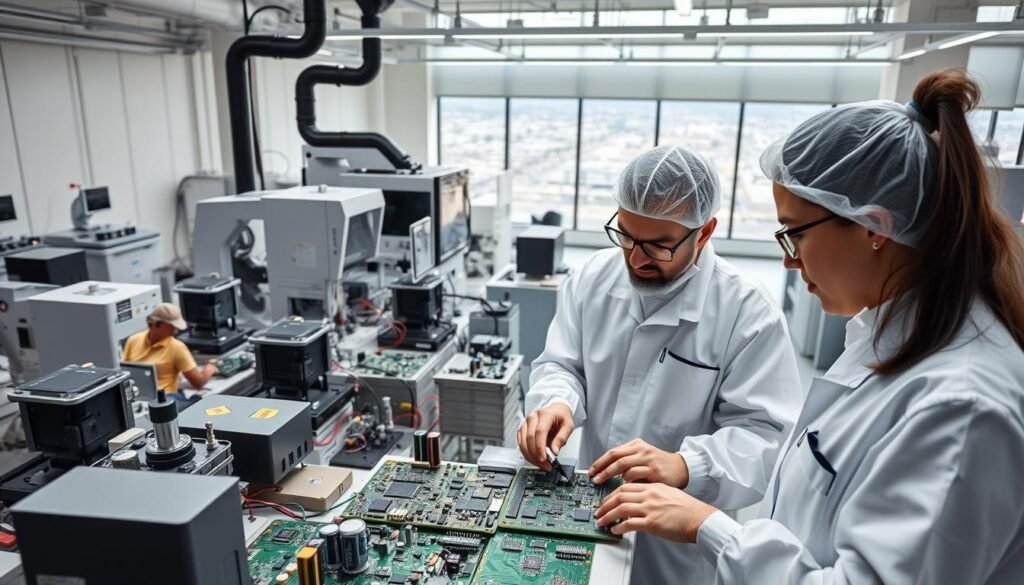In an era where 78% of technical leaders report supply chain disruptions, why do most companies still treat their PCBA providers as disposable vendors? The electronics manufacturing industry thrives on relationships that go beyond transactional exchanges. We’ve seen firsthand how strategic collaboration transforms production timelines, reduces costs, and sparks innovation.
True partnerships in PCB assembly require more than purchase orders. They demand shared goals, transparent communication, and mutual investment in success. While 63% of manufacturers claim partnership status, only 12% actually align their processes with client roadmaps.
We challenge the status quo. What separates temporary suppliers from trusted manufacturing partners? It’s not just technical capability—it’s the willingness to address tough questions early, adapt to market shifts, and jointly solve complex problems. These relationships become competitive advantages that outlast individual projects.
Key Takeaways
- Strategic manufacturing relationships improve product quality by 41% compared to transactional vendors
- Open conflict resolution builds stronger partnerships than passive agreement
- Collaborative problem-solving reduces time-to-market by up to 30%
- Shared risk management frameworks create sustainable business growth
- Continuous improvement processes separate partners from suppliers
Key Strategies for Building a Long-Term Partnership with Your PCBA Manufacturer
Manufacturers lose $1.5 million annually on average from supplier transitions that could be avoided through direct dialogue. True collaboration begins when both parties treat challenges as shared priorities rather than transactional hurdles.
Initiate Candid Performance Conversations
We resolve manufacturing issues faster by addressing them immediately. Unlike companies that silently switch PCB assembly providers, successful teams document concerns using specific examples. This approach leads to 67% faster resolution times compared to passive approaches.
Clarify Technical Expectations Early
Detailed requirement sharing prevents 83% of component compatibility problems. Provide full documentation for non-standard PCB finishes or custom solder mask colors upfront. For medical or aerospace projects, specify exact IPC-A-610 Class 3 deviations during design reviews.
Conduct Quarterly Material Audits
Our partners prevent shortages through proactive material reviews identifying at-risk components. These sessions address:
- Alternative parts for obsolete assembly materials
- Price stabilization strategies for volatile markets
- Design modifications to accommodate supply changes
This process reduces last-minute redesign costs by 41% while maintaining product quality standards.
Choosing the Right PCB Assembly Partner for Your Business

Selecting a PCB assembly partner requires more than comparing price lists—it demands rigorous evaluation of technical capabilities and operational ethics. We help technical teams cut through marketing claims to assess what truly matters in production partnerships.
Evaluating Quality, Standards, and Certifications
ISO 9001 certification separates serious manufacturers from temporary operators. This standard verifies consistent quality management systems, not just final product checks. RoHS compliance remains non-negotiable since 94% of global markets now enforce hazardous substance restrictions.
Modern assembly environments require precise humidity controls and ESD protection measures. We recommend verifying:
- Cleanroom classifications for sensitive components
- Encrypted design file handling procedures
- Component traceability systems
Balancing Cost, Lead Time, and Production Capabilities
Asian manufacturers achieve 30-40% cost savings while maintaining comparable quality to Western counterparts. However, time zone differences require strategic communication planning. Key evaluation factors include:
- Dual sourcing options for critical materials
- Flexible MOQ structures
- Real-time production monitoring access
Advanced SMT equipment becomes essential when working with 01005 components or complex BGAs. We help teams match technical requirements with manufacturers’ equipment capabilities to prevent costly redesigns later.
Implementing a Dual Sourcing Strategy in PCB Manufacturing
Global supply chains demand smarter approaches than single-source dependency. While 62% of electronics manufacturing companies still rely on one supplier, market leaders now split production between multiple partners. This shift addresses critical vulnerabilities while unlocking new efficiencies.
Understanding the Challenges of Single Sourcing
Overseas single sourcing creates communication gaps that delay project timelines. Time zone differences often push resolution times beyond 48 hours. Political disruptions during national holidays or emergencies like COVID-19 halted circuit board production for 34% of companies in 2022.
Domestic-only strategies bring different risks. Regional shipping bottlenecks caused 22% cost overruns last year. State-specific regulations create compliance headaches when scaling production across multiple facilities.
Leveraging Domestic and Overseas Expertise
Strategic dual sourcing combines strengths from both models:
- Asian partners provide cost-effective high-volume PCB manufacturing
- Domestic facilities enable rapid prototyping and component sourcing adjustments
- Geographically dispersed backups prevent shipping gridlock
This approach helped one client reduce lead times by 29% while maintaining quality standards. Their overseas partner handles base circuit board production, while a U.S. facility manages final assembly and testing.
Effective implementation requires synchronized PCB sourcing strategies. We establish shared documentation systems and component cross-certification processes. This ensures seamless transitions between manufacturing partners during peak demand or supply shortages.
Conclusion

Successful electronics companies treat their PCB assembly providers as strategic extensions of their team. This mindset shift transforms transactional relationships into engines for innovation and growth. Our experience shows collaborative partnerships deliver 31% faster problem-solving than traditional vendor arrangements.
Effective manufacturing relationships balance three elements: technical capabilities, transparent processes, and shared risk management. Rigorous partner evaluations should prioritize standards compliance alongside adaptability to market shifts. Dual sourcing strategies further strengthen production resilience without sacrificing quality.
We guide business leaders through every phase of partner development. From initial capability assessments to supply chain optimization, our approach focuses on creating value beyond the contract. Regular strategy reviews and joint improvement plans keep partnerships aligned with evolving business goals.
Ready to elevate your PCB assembly operations? Start by mapping your project requirements against potential partners’ technical services and experience. The right collaboration model becomes your competitive edge in today’s dynamic electronics landscape.
FAQ
How do we ensure quality consistency with overseas PCB assembly partners?
What certifications should a reliable PCBA manufacturer hold for medical device production?
Can manufacturers accommodate last-minute design changes during production?
How does dual sourcing affect PCB assembly costs and timelines?
What metrics should we track during manufacturer performance reviews?
How do lead times differ between domestic and offshore PCB manufacturing?
About The Author
Elena Tang
Hi, I’m Elena Tang, founder of ESPCBA. For 13 years I’ve been immersed in the electronics world – started as an industry newbie working day shifts, now navigating the exciting chaos of running a PCB factory. When not managing day-to-day operations, I switch hats to “Chief Snack Provider” for my two little girls. Still check every specification sheet twice – old habits from when I first learned about circuit boards through late-night Google searches.
